EMD's experimental GM6C #1975, a C-truck 6000hp electric freight locomotive, hooked to a Penn Central-owned GE-built E44. In the early '70s, during the gas crisis, EMD tried to market a pair of large electric freight locomotives, thinking electric locomotives might take off. Instead, the GM6C and GM10B, a B-truck variant, hung around for a few years before being cut up for scrap. The problem: Penn Central was the only freight-hauling electric railroad and they were flat-out bankrupt. Milwaukee Road had torn down their catenary a few years earlier, essentially cutting their own throat, and was also in poor financial condition. Great Northern had de-electrified in '56. Virginian Railway's electric operations had been eliminated after the merger with Norfolk & Western. And no railroads built new electric operations, although others considered it.

The front of these always reminded me of a cockatoo.
Canadian Pacific #144, a Class A2Q 4-4-0, blowing down her boiler. This photo was taken in 1959! Due to light rail and light service, the CP kept a trip of 4-4-0s in service on their Chipman branch well until 1959, long after the 4-4-0 had disappeared from essentally every Class 1. The #144 was built in 1886, so she was 73 years old then. The caboose in the foreground was not for train use, but was the living quarters for the Chipman branch crew. In the opening of his book The Mohawk That Refused to Abdicate, David Page Morgan recounts traveling by rail to the Chipman branch just to hunt down the 4-4-0s in '54

That bridge in the background is a big reason why the #144, #136 and #29 got such a long lease on life.

Similarly, Wabash operated a pair of 1899-vintage Moguls on their line from Keokuk, Iowa to Bluffs, Illinois. This was the last stand of steam on the Wabash, from 1953 to 1956. And it was because of light axle loadings, particularly on the bridge at Meredosia. When the bridge was replaced in '56, the Moguls were retired.

It's often thought that steam went out with a roar, with the big new Texas and Challenger and Berkshires making the last stand against the diesel. But the reality is, the newest biggest engines were often the first to go. There was more money to be saved on the mainlines by dieselizing. So usually, the last holdouts were tiny little branch lines that didn't warrant the expenditure of diesels, leaving turn of the century Moguls and Ten-Wheelers closing out the steam era.
New York Central F12-class Ten Wheeler on the bucolic Putnam division. These dated back to the F2s from 1907 and were steadily overhauled and modernized over the years, becoming F12s. This photo was taken in '51. By 1953, all lines east of Cleveland, Ohio on the New York Central were fully dieselized, leaving Lines West the last holdout. By '57, they were all gone.
In reply to NickD :
I ride my bike from time to time on the rail trail that the Putnam Division (the "Old Put") has morphed into. I'm trying to figure out where that photo was taken, but there's not much to go on, and there's been a massive amount of building around here since 1951.
In reply to NickD :
Huh. I'll have to look and see if that building is still there. YH used to have an HO-scale layout of some of the Old Put in the town museum, but I haven't been there in decades, so it may well be gone.
In reply to 914Driver :
Or is it heat-buckling? You lay down miles of steel rail and then heat it up on a good 100+ degree day and the expansion will do that. Or on a cold day, it'll contract and snap a steel rail in two.
Or, sometimes, someone hits your bridge and doesn't report it and knocks everything out of wack. Which just happened to East Broad Top. Over the weekend, somebody hit their bridge with a truck and shifted the whole deck over a few feet and drove off and never reported it. From the impact mark, my guess is excavator on a flatbed. So now, on top of undoing almost a decade of decay from sitting, they have to repair a bridge that's been there for over 100 years because someone couldn't check heights.




On the subject of tiny old engines with long lives, one of the existing engines that I feel bad for is Delaware, Lackawanna & Western #565. Built in 1908 by Alco, the #565 was a class 10c Mogul with 63" drivers and Walschaerts valve gear, and considered a DL&W second-generation steam locomotive (replacing earlier steam engines that were being scrapped). At an unknown point in time, believed to be between 1913 and 1917, the DL&W shopped at least the #565, unknown if any of her sisters as well, and replaced the slide valves in the valve gear with piston valves, as well as superheating the boiler to get more power out of her, and swapping on a different headlight and adding a second air compressor. Photos of the #565 in her original DL&W days are hard to find, as it lived a seemingly ordinary career.
By 1936, the Mogul was falling out of favor, and the DL&W was purchasing larger triple-cylinder 4-8-2 Mountains and 4-8-4 Poconos. So the DL&W began scrapping their smaller engines, and the #565 was one of the engines slated to be retired. Enter the Dansville & Mount Morris, a 9 mile short line that had originally been built as the Erie & Genesee Valley in 1894. After entering receivership in the '20s, it was reorganized as the Dansville & Mount Morris. And it was a small operation. Nine miles, two stockholders, fifteen employees and two locomotives: the #565 and an older Ten-Wheeler #304. The D&MM never operated both engines concurrently. Instead, they would park one engine for a year and perform maintenance and repairs on it while operating the other, and then the next year alternate out. In his book The Mohawk That Refused To Abdicate, David Page Morgan recounted visiting the D&MM, although the #565 was the engine under repairs at the time, so he only saw the #304.

But, by 1961, the siren song of the diesel called to even the little D&MM and they purchased a GE 44-tonner, in fact the very last 44-tonner that GE would build. The #565 was snapped up by the just-opened Black River & Western tourist line, who was operating on the Central Railroad of New Jersey's Chester branch, and used until 1962. At that point, the Black River & Western got ousted from the old CNJ site, and moved to their modern days site of the PRR Ringoes-Flemington branch.



When the BR&W relocated to Ringoes, they parked the #565 first at the Flemington Lumber Company at the Flemington end, and then later relocated it to the main station at Ringoes. As the BR&W was getting established for operations at their new site, they did not operate any steam excursions from '62 to '65. In '65, they looked at firing the #565 up, but it didn't have an of it's ICC boiler paperwork, which would require a teardown, and it's running gear also had some wear and would require replacement of parts, like rear tires. Remember, the #565 had not been through a major shop since before '36 at this point, other than the D&MM's tinkering over the years. Instead they, purchased Great Western Railroad Of Colorado #80, a newer, bigger, more powerful 2-8-0 that was in better condition.
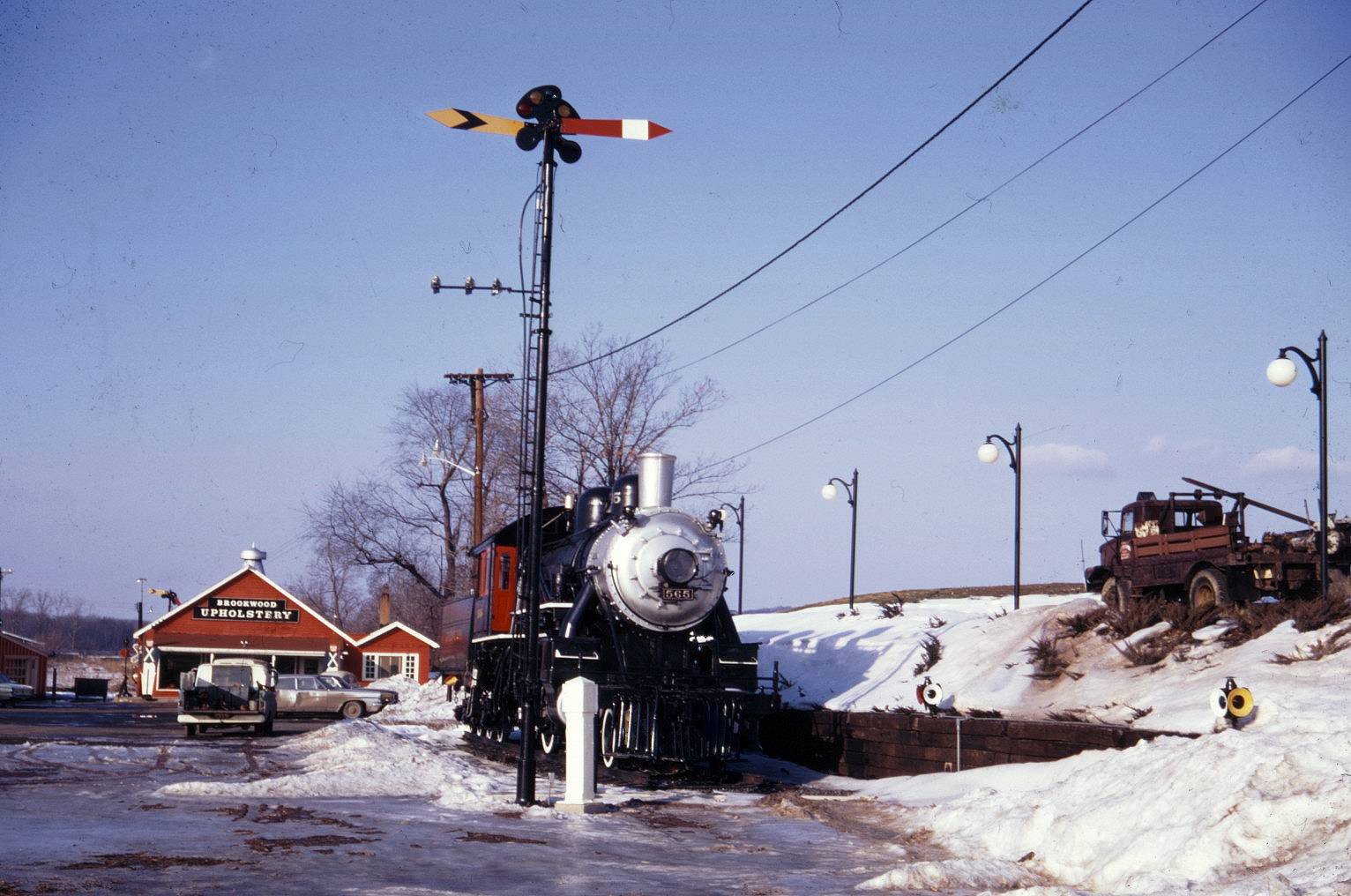
So, being surplus to its needs, and with BR&W being a financially lean company in those early years, they sold it in 1967 to a John Maris, vice president of the Morris County Central, a tourist line operating on the Morristown & Erie's rails. The #565 was moved to Whippany, NJ, where it had a hydrostatic test performed and some minor repairs, all in hopes of operating it on the MCC. But the MCC and the M&E's relationships became strained and Maris instead sold off the #565. The #565 was then purchased by a restaurant owner by the name of Anthony Citro, who wanted it as a display at his restaurant. The #565 was cleaned up and painted in DL&W lettering and displayed in Wayne, NJ.

Citro decided he wanted to restore the #565 to operation, and began having mechanical work performed at the restaurant by the Menair-Fetzer Corporation. The MCC had moved it's operations to New York, Susquehanna & Western's tracks in Newfoundland, NJ and Citro bought out John Maris' stake in the MCC, with the intent of running the #565 there. But the #565 first needed mechanical work that could not be performed in a restaurant parking lot, so it was sent to New Hope, PA to be overhauled at the New Hope & Ivyland's shops and then run at the NH&I's Bicentennial event. But before leaving Wayne, NJ, the Menair-Fetzer contractors cut the ashpan and firegrates out of the #565 for a planned coversion to oil-burning (a bit sacrilegious considering the DL&W was the "Road of Anthracite") At New Hope, the running gear was disassembled and sent out to machine shops for refit and repair, the tender was modifed to hold oil in place of coal, and the pilot, pony truck, smokebox front and boiler jacket are all removed. This is really the beginning of the #565's downward spiral. The restoration stretches on past '76, Frank Menair leaves the Menair-Fetzer Corp to go head up the new Adirondack Scenic Railroad and Tony Citro gets in over his head financially and halts work and tries to sell the #565 off, which he does in '82, to a gentleman in Elmira. Citro would die in 1989, and his restaurant close shortly afterwards.
The new owner would try and hunt down the missing parts, which were numerous, and consolidate it. There were parts scattered all over the northeast, as it had transferred owners and they had each tinkered with it and sent them out to various machine shops, and then they had never been returned before it transferred owners again. The #565 would never actually move to Elmira, but would stay on the New Hope & Ivyland and was just moved out of the way.
In '83, Don Ball, a photographer and author of railroad books, got involved. Ball had also been involved with the '76 American Freedom Train and had taken over as director of Steamtown USA. This was back when Steamtown was still a privately run park and was located in Bellows Falls, VT, operating over the old Rutland rails. Ball knew the historical significance of the #565, as it was only one of 2 surviving DL&W locomotives. So Ball purchased it for $2500. At this point in time, Steamtown USA, which had been financially hard-up since founder Nelson Blount's death in '67, was preparing to move to Scranton, PA. This would give it access to a larger population pool, plus they would get the old DL&W roundhouse and locomotive shops. Steamtown wasn't moving yet, but Ball was under pressure to move the #565 to Scranton ahead of the move. So he planned to sell it to a gentleman who was renovating the old DL&W Scranton station into a hotel, and display the enginer there, and then once Steamtown made the move, the #565 would either be sold or donated back to Steamtown.
The whole move turned into a debacle. Ball could not personally oversee the move, as he was busy hammering out Steamtown's move. The NH&I owners disassembled the #565 and loaded it on the trucks, but the trucking company felt the fees were exorbitant and Ball advised them to stop paying, which lead to a court case. Then, the trucking company owner, who was running for Scranton commisioner, towed the locomotive around Scranton on a trailer for days with campaign banners on it, leading to Ball getting angry with him for using it for political purposes. Then, after moving it to the hotel, the hotel partnership fell through and the gentleman leading that charge left town.
Ball tried to find a home for it in Scranton but began to encounter the same feelings that the DL&W itself had run into years before. The DL&W had tried to donate a 4-8-4 Pocono to Scranton and Scranton had said they would only accept the donation if the DL&W paid to move and relocate the locomotive to Nay Aug Park. The DL&W refused and the city wouldn't take the engine, so the only large modern DL&W steamer remaining was cut up. And Ball's relationship with Steamtown began to sour and he was replaced as general manager. On the subject of DL&W #565, Ball said:
"I reached a point of exasperation and recently let it be known in historic
preservation circles that the engine was unappreciated and up for sale. A
flood tide of interest ensued - unfortunately, none of it local to the
Scranton area. However, fortunately, there is still good reason for hope
for this locomotive in Scranton. Through heart-felt conviction, I decided
to pursue a sale with the one individual who shares the vision of retaining
this historically significant Lackawanna Railroad engine on home rails.
This individual has the interest and wherewithall to restore the locomotive
into a crown jewel, and it will now be up to the Scranton officials and
community leaders to work together with the new owner to show good faith.
The story should have a very happy ending."
The new owner was a man from Canada by the name of Horst Muller, who bought #565 on August 21, 1984 for $8,500. The locomotive remained at
Scranton, and Muller began negotiations with Steamtown USA to arrange an exchange. On January 17, 1985, Muller gave Steamtown $5,000 and ownership
of #565 (remember, Don Ball owned the #565, not Steamtown). In exchange, Muller received ownership of Canadian National 2-6-0 #96 which had been owned by Steamtown USA and was still in Bellows Falls.
The #565, still disassembled, sat around Scranton for many years, with parts still missing, although occasionally turning up at places like BR&W, NH&I and even Rome Locomotive Works and being sent to Scranton. As one person in 2004 recounted: "The locomotive has gotten minimal attention over the years. Parts were scattered to the four corners of the railroad yard. I saw drive rods sitting at the old DL&W scrap dock a few years ago (near the old visitor center), the lead truck wheelset is in front of the shop. The lead truck frame was feared to be accidentally scrapped during a parkwide cleanup effort about 8 years ago, but may have since re-appeared. The pilot is between the shop and roundhouse. Several barrels of parts that had made their way to the Rome Locomotive works and then re-patriated had been kept near the coal pile, but were bulldozed over when the park constructed a shed to store road salt. I have pictures of the bulldozed parts too, if I can find them."
Yep, pretty grim. In 2011, there was a surge of hope for the #565. A team began working on the #565 to get it cosmetically restored. Operation was out of the question, just too many missing parts for an engine that was described in the National Park Service brief as "terrible condition", but they wanted to get the #565 spruced up and looking complete as a nice static display, due to its historical importance. Everything was being cleaned up, parts were being moved together, a new cab was being built, and then it all came to a halt, when it was found that required National Park Service paperwork had not been completed, and thus work could not continue, and the employee whose job it was to fill out the paperwork was engaged in a pissing match with other members of the park due to being overworked. Thus the #565, one of only two DL&W engines and the only one on home turf, now sits disassembled, with allegations of more parts going missing or being stolen as well.
It is interesting to note that also at Steamtown is Nickel Plate 4-6-0 #44. Why do I mention this? Because Nickel Plate #44, on top of being the oldest surviving NKP locomotive, was later renumbered to #304 and sold to the Danville & Mount Morris. Yep, Steamtown ended up with both of the D&MM's steam locomotives. NKP #44 has not received any work, but is also just as unlikely to be restored to operation, as it is also considered to be in "terrible condition".

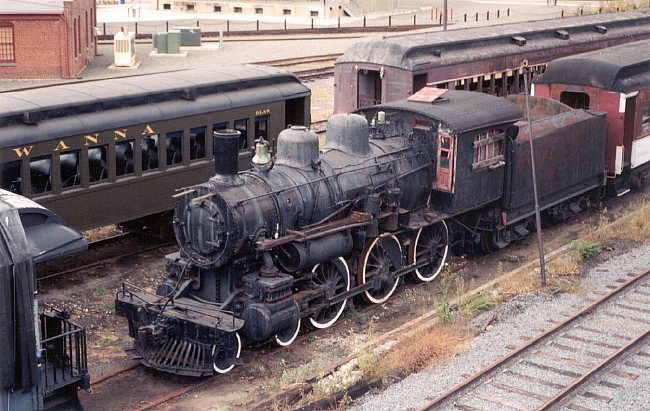
Nick, how about a story about the Washington, Idaho and Montana Railway?
Mostly a timber railroad, but they also serviced some grain elevators as well. They were eventually purchased by Milwaukee Road. I think the little town of Palouse, WA once had NP, GN and Milwaukee Road all serving it. Not sure if UP also went there off hand, if they didn't, they were close by.
There is an Alco 4-6-0 on display at Potlatch, ID. There also is ex-Potlatch Lumber Company #24 that is now running as Black Hills Central #108.
EDIT: In other words save me from buying a $45 book about the W,I&M.
In reply to T.J. :
Wow, that's an obscure one. Let me see what I can dig up. RRPictureArchive doesn't seem to even list it
In reply to NickD :
The best info I found on it is on the historical society page.
That site looks like it hasn't been updated in a while.
There is also a facebook page for them: https://www.facebook.com/wimryhpg/
I'm guessing there is an interesting story of how locomotive #1 got to be displayed at Potlatch, ID. Potlatch is not a big town, but they have this old engine on display:

Your posts above about how some of the older, smaller steamers hung around for a while into the diesel era, made me wonder about it.
The W,I&M was only 46 miles of mainline and ~10 miles of sidings and side tracks, but stations on the line included Wellesley, Princeton, Harvard, Yale, Stanford, Vassar, Cornell, and Purdue. Out of these places, only Princeton seems to have been named that prior to the railroad. The others may have been named after other colleges by the survey crew as a bit of a joke.
So, did some digging on the WI&M. Around 1900, a group of Midwesterners formed the Wisconsin Log & Lumber Company and began developing a plan to log out the large virgin white pine forests in Idaho's Potlatch Basin. They merged with Weyerhauser interests in the area in 1903 to become the Potlatch Lumber Company. Wanting to construct a new mill near the Bovill, Idaho forests, they decided to abandon the Palouse, Washington mill and construct a larger one closer to the site. The original spot they chose to build the mill was Moscow, Idaho, and they originally planned to build a railroad known as the Moscow & Eastern. But Moscow real estate prices would have forced Potlatch Lumber Company to shell out significant money both for the mill site and the railroad right of way. And as one company officer said "there wasn't enough water in Moscow to baptize a bastard", so they couldn't even float the logs to the mill on a river.
So, they moved 18 miles east and began building the new mill, essentially in the middle of nowhere, and the town of Potlatch sprung up around the mill as a company town. They originally got in contact with Northern Pacific and asked them to build a line to Potlatch and then into the timber, to transport logs to the mill and then away from the mill to customers, but Northern Pacific believed that the anticipated tonnage would not be enough to warrant the expense of construction, and left Potlatch Lumber Company no choice but to build their own railroad: the Washington, Idaho & Montana. Its interesting that while the lumber company built the WI&M and collected bonds and stocks, the WI&M was an entirely seperate entity under its own management, until 1932.

Construction on the line began in 1905, and by the end of the year, they had constructed 20 miles of track from Lairds, Washington to Harvard, Idaho. By the end of the next year, they had completed the route to Bovill, and then the next year they constructed an extension to Purdue to provide access to Potlatch Camp 8. The estimated cost of construction and equipment for the 46 miles of main line and ten miles of yard and side tracks was $1,147,882.00 for construction and $295,650.00 for equipment; the total actual cost to January 31, 1908 was $1,839,739.28 for construction and $326,439.99 for equipment. Where does Montana come into the equation? The original plan was for an extension to be constructed at a later date to cross the Bitterroot Mountains into Montana. But in 1909, an agreement was drawn up between Chicago, Milwaukee & Saint Paul (the Milwaukee Road) and the WI&M to use the Milwaukee Road's subsidiary Chicago, Milwaukee & Puget Sound's trackage, which met the WI&M at Bovill. This gave both lines joint use of tracks and division of rates. The other reason the Montana extension came to pass was that a huge forest fire swept through that area and destroyed most of the valuable timber.

The agreement with the Milwaukee also came with an agreement that the WI&M would not be sold out to anyone for at least 10 years. But the Northern Pacific, who got nervous when Milwaukee started building in that area, gave the WI&M an ultimatum in: Sell out to us for $25,000,000 or we'll build our own line exactly parallel and run you into the ground. Apparently, Weyerhauser was tempted to sell out, but couldn't get the other board members to agree to break the agreement with Milwaukee Road, and instead called NP's bluff. NP didn't build the parallel road, as threatened, but they refused to agree on joint rates with the WI&M until 1922.
The WI&M would begin operations with a collection of Alco-built 4-6-0s. No clue on how many they had total, as a roster seems impossible to find, but they had at least 2, as there is the preserved #1 and a photo of a #2.

They also had at least 2 Alco-built Consolidations with superheaters, #20, and #20


There was also a #23, a 2-6-2 Prairie, that WI&M only owned shortly before transferring it to Potlatch Lumber's operations

Potlatch Lumber also owned a number of Shay gear drive locomotives, which they used back in the woods to haul loads out to the WI&M right of way.


Around '33, the WI&M decided to stop operating passenger service in the form of locomotive-pulled passenger cars, as the small amount of passenger service that they did could not justify that expenditure. The WI&M shops took a Studebaker car from the Potlatch Logging Company and modified it to drive on the rails to provide passenger service, as well as mail and express. Sadly, no photos seem to exist of this beast known as "The Bug". In '37, The Bug was retired and replaced with a doodlebug that was known as The Potlatcher. Guess all the snappy names, like Mercury and Zephyr were taken, or the WI&M folks weren't particularly creative.

The Potlatcher, both the doodlebug and the train, would meet its end in '55, with the mail service's cancellation of their contract with the WI&M. Passenger fares were no longer enough to keep passenger service in operation and the The Potlatcher was presumably scrapped.
In 1950, they purchased their first diesel locomotive, a brand new Alco S3 that was numbered 1930.

It was followed by a used Alco HH-660, a rare unit when new, that they purchased from the Minneapolis & St. Louis sometime in the mid '50s.

Although the main purpose of the WI&M was to haul lumber, it also worked closely with farmers in the region. It transported grain into the area, and shipped out livestock. It also renewed mining interest in the Palouse area. But there was clearly a decline in the service over the years as the forests played out. In 1936, the WI&M had five locomotives, two passenger coaches, fifteen standard box cars, 300 flat cars and it ranked among the very top in terms of reliability and service. By 1960 the equipment consisted of two diesels, sixty log flats, and two cabooses. At the time of construction, logging operations had only been a mile away from the city of Potlatch, but now operations were 37 miles out. The WI&M had simply outlived its original usefulness. So in '62, Potlatch Lumber put the line up for sale, and the Milwaukee Road stepped in and bought the line. The WI&M would continue to operate under its own name, although it used Milwaukee Road locomotives.

In 1980, the long-ailing Milwaukee Road kicked the bucket and the WI&M came under ownership of Burlington Northern. BN stopped using the WI&M name, but the tracks were still in use. The Potlatch mill finally closed in '81, but BN hauled grain from Palouse and lumber products from Bennett Forest Products in Princeton.

In '95, Burlington Northern merged with Santa Fe to form Burlington Northern Santa Fe. A year later, a flood wiped out a lot of the eastern end of the line. WATCO purchased what was left, abandoned the line past Harvard and operated what was left as the Palouse River & Coulee City, serving just two customers. After 10 years, WATCO bowed out and it is now operated as the Washington & Idaho, with Bennett's lumber mill as it's only active customer.




When it comes to "steam engines that hung around long after their time", there is one bunch that stands above the rest. And it's not UP #844. True, it was never retired, but it spent a bunch of years just being used to melt snow and ice in the Cheyenne yard, and then it became an excursion queen. Nope, it's the Northwestern Steel & Wire fleet, which had the last steam locomotive in general revenue in the US. The date: December 3rd, 1980.
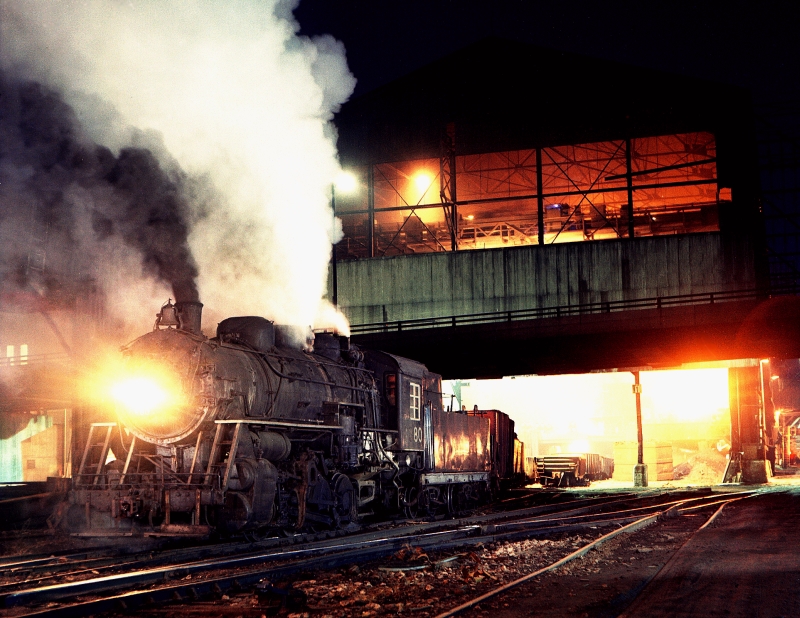
NWS&W began life as a barbed wire factory in Sterling, Illinois in the 1890s. In 1936, the first electric furnaces were purchased and it became Northwestern Steel & Wire. It would actually also hold a record in the 1970s, when it had two 400 ton electric furnaces installed, the largest in the world, with a 3rd 400 ton furnace being added in 1979. To move scrap metal to the furnaces and transfer ingots to the rolling machines, NWS&W built an internal rail line, and purchased retired secondhand 0-6-0 switchers from local railroads, usually the CB&Q.


For years, NWS&W was viewed by railfans as "the enemy", as many steam locomotives came through their gates, were cut up into pieces and then hauled to the furnaces by their Judas goat switch engines. But something odd happened in 1960. The Grand Trunk Western was retiring their P-5-g 0-8-0 switcher fleet and sent the 15 of them to NWS&W to be cut up and melted down. On arrival though, the NWS&W mechanics realized that most of these engines were newer, more powerful and in better shape than their CB&Q 0-6-0s and instead, scrapped all of their 0-6-0s and the 3 worst 0-8-0s, and put 12 of the ex-GTW engines into service. The engines were all renumbered by NWS&W by taking their original 4-digit number and painting over the first 2 digits, so for example, the #8325 became #25. The lone exception was the #8300, which became #30 instead of #00.
The engines continued to take on their own identities at NWS&W over the years, as the yard made modifications. Headlights rewere moved, or relocated, or swapped off of different engines that had been scrapped or were slated for scrap. Same with bells and whistles. Tenders were exchanged with different engines as well. For example, #15 gained the tender from a CB&Q Mikado, while the #28 received a "Mars Light" gyrating headlamp off a CB&Q engine
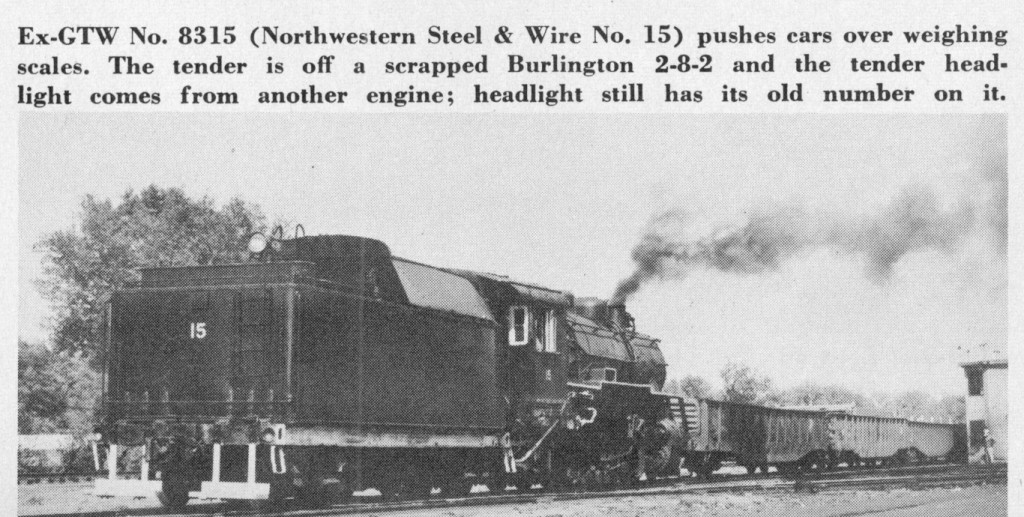
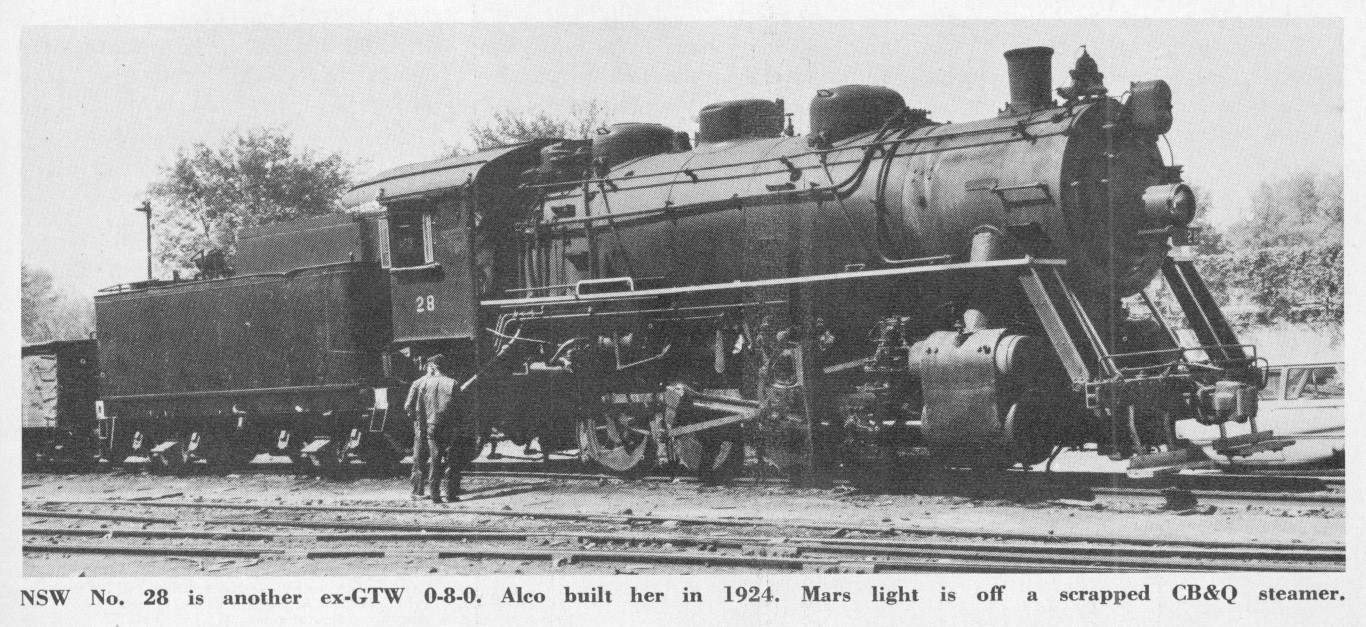
In the '70s, NWS&W converted a number of engines to oil burning. Rathern than convert their old tenders to oil cisterns, they used tenders off of scrapped engines, resulting in the oddest engine, the #28. They wanted to use an old Vanderbilt tender off a Soo oil burner, but the oil tank would clear the roof awning on the #25, so they hooked the tender up backwards and ran oil lines to the end of it.

As the '60s continued on and the last pockets of steam usage in regular operation were wiped out, NWS&W went from being "the enemy" to the last place to find steam locomotives doing the job they were designed for.






As the years dragged on, engines wore out and were slowly retired, but set aside to provide parts for the remaining engines. Finally, in 1980, the end came, and NWS&W bought their first diesels and put the fires out in the 50 year old switches for the last time. #73 holds the honor of being the last steam locomotive in the US in revenue freight service.

At first it seemed like the engines might be cut up like all the rest that had crossed through those gates in Sterling, Ill, but in a shocking and generous move, the steel company donated all 12 surviving to the Illinois Railway Museum. Suddenly, an engine that the GTW hadn't bothered to set aside for preservation became the most populous GTW engine in preservation. But IRM now had 12 identical engines to try and squeeze into their collection, on an already crowded site? What to do? Well, no. 80, was cosmetically restored in her original guise as GTW 8380, and placed on display at the museum's Union, Illinois site. Homes were found for several others as well. No. 27 went to St. Paul, Minnesota, for display outside a railroad-themed shopping complex converted from a former Northern Pacific car shop. The city of Amboy, Illinois got no. 76 and put her on display outside their depot museum, while no. 73 remained in NSW&W's home town of Sterling, Illinois, placed on display at the P.W. Dillon museum (P.W. Dillion being NSW&W's founder). Three more, #74, 05, and 30 were placed in open storage on a siding in Galt, not far from the NS&W yard in nearby Sterling, and left there to rust until a decision could be made on their fate.




Since that time, at least one has been removed and cosmetically restored. And the last five? Well, they were not so fortunate. The IRM traded them in the 1980s to a Chicago scrapyard to spring CB&Q Mikado #4963 from where she had been sitting since 1971 after being illegally evicted from the C&EI roundhouse while owned by Dick Jensen.


The irony that these engines that once dragged so many steam engines to their demise gave their lives to save one last engine is not unrecognized. Neither is the fact that although an 0-8-0 was the last steam locomotive to operate in a non-excursion service, there has never been an 0-8-0 restored to operation. Also, I think that the GTW holds the record for most amount of steam locomotives scrapped in the preservation era. Between the five 0-8-0s and Dick Jensen's Pacific #5629, there were at least 6 GTW steam engines scrapped in the 1980s
You'll need to log in to post.